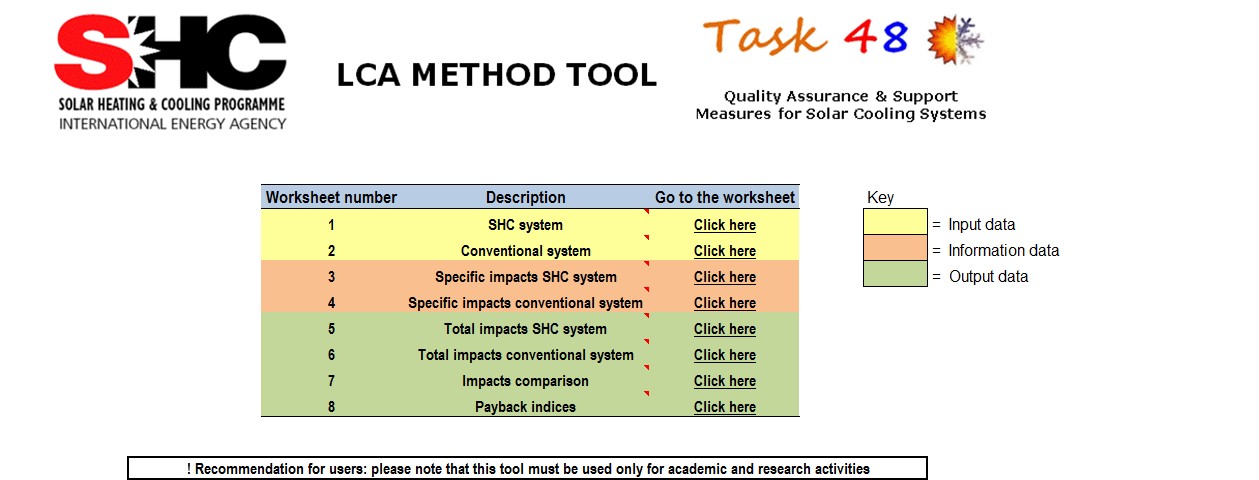PISTACHE Tool (Presizing tool for solar cooling, heating and domestic hot water production systems)

The PISTACHE software is a tool to pre-size and evaluate the performances of solar installation for cooling, heating and domestic hot water preparation, with or without energy back-up system.
The tool aims to realize easy and quick calculation of solar installation for cooling, heating and DHW
production. It helps the user to pre-size the installation and provides energy balance and annual
performance indicators.
The tool is composed of a user interface to upload an input file, to fill the parameter and to choose the main
component characteristics. The tool also includes the calculation tables, the material databases and a step
by step help file.
To use PISTACHE, you need to get annual hourly data with meteorological data of the concerned site, cooling and heating loads and the net domestic hot water demand. The data must be provided in a text file with a specific format; the format is given in the step by step help of the software.
PISTACHE distribution is free of charge. It has been developped by TECSOL and the CEA at INES in the MeGaPICS project, partly financed by the Agence Nationale de la Recherche (ANR) in the framework of the HABISOL program.
To get more information or freely download the tool, please directly go to the following link: https://pistache.ines-solaire.org/



LCA Method Tool
The LCA Method Tool is a tool for applying the Life Cycle Assessment (LCA) methodology, which is a technique for assessing the energy and environmental impacts associated with all stages of a product’s life cycle from cradle to grave. LCA Method Tool can be used to create life cycle energy and environmental balances of SHC systems, to carry out simplified LCAs, and to compare the SHC systems with conventional ones.
Data on specific energy and environmental impacts of different components of SHC and conventional systems are provided with the tool. LCA Method Tool can easily be expanded with the life cycle data of new components or updated with new life cycle data for the existing components.

The visualization approach of the tool enables users to build the SHC system model by using a clear and transparent structure. Input data, specific impacts, total impacts are reported in separate worksheets; therefore, each worksheet can be easily consulted or compiled. The LCA results are displayed both in tables and in figures and are referred both to specific life cycle steps (manufacturing, operation and end-of-life steps) and to the total life cycle.
The tool is developed in xls format and contains the following worksheets:
- Index;
- SHC system;
- Conventional system;
- Specific impacts SHC system;
- Specific impacts conventional system;
- Calculation (hidden sheet used to make calculations);
- Total impacts SHC system;
- Total impacts conventional system;
- Impacts comparison;
- Payback indices.
The tool can be used only for academic and research activities.
Technical and Economic Key Figures Tool
This Excel tool is permitting to go for an appropriate evaluation procedure for the technical and economic performance assessment of large systems is set up and tested with real cases.
It delivers the basis for a comparable assessment of the installed plants independently of installation site and the specific boundary conditions. Beside, a reflection will be carried out on minimum economical ratios to estimate the competitiveness of solar cooling against concurrent technologies.

In addition of using this tool and for further information on the methodology, it is advised to read the Task 48 B7 final report:
Task 48 Training Material
This set of training slides has been developed within the IEA SHC Task 48. It can be used by individuals as a summary of the state-of-the-art in solar cooling. Alternatively, it can be used for general training of engineers in solar cooling system design. When used for training, it is intended that delivery is done over a full day, by an engineer with high knowledge and experience of solar cooling.
You are encouraged to contact the Task 48 Operating Agent (daniel.mugnier@tecsol.fr) to discuss the availability of suitably qualified engineers who can help to deliver the training course.
This material has been prepared by volunteers, under the umbrella of the International Energy Agency, and is intended for widespread distribution with the intent of advancing the solar cooling industry for the public good. It is not intended for commercial purposes. If you download this material, you acknowledge and agree that
- The material is licensed to you under creative commons (web link to be supplied – see below)
- You will not on-sell or seek to commercialise this material in any way
- You will acknowledge us, if you use the material
- The material provided is not a complete description of all the information you may require to design and build a solar cooling system. Hence you should not rely on this information. Instead, you should seek your own independent advice before implementing any suggestions contained in this material.
- You use the material at your own risk. To the extent permitted by law, the IEA (including its employees and consultants) excludes all liability to any person for any consequences, including but not limited to all losses, damages, costs, expenses and any other compensation, arising directly or indirectly from using this publication (in part or in whole) and any information or material contained in it
.The content of this material can be seen below :
|
Introduction
|
- Why solar air conditioning?
- Existing energy demand for cooling
- Perspectives and targets/obligations at national and international level
- Peak load issues and energy prices
- World and national market for conventional cooling systems (from luxury to necessity)
- A short review of existing solar cooling applications
|
|
Main presentation, part A
|
- Load sub-system concepts and (solar) air-conditioning equipment
- The cold production sub-system
- Chillers (vapour compression, absorption and adsorption)
- Desiccant cooling systems
- Heat rejection equipment
- The heat production (solar) system (collectors and backup), including state of the art on concentrating and new collectors
- System configurations (solar assisted and solar autonomous systems) and control
- Design approaches
- Preliminary design aspects, backup sources and efficiency benchmarks
- Dimensioning a solar cooling system (collector area, storage volume)
- Lessons learned
|
|
Lunch break
|
|
Main presentation, part B
|
- Performance figures
- Energy performance and primary energy balance, including COPel, electrical consumption of heat rejection and efficiency improvement potential for other components
- Economic analysis
- Brief description of contracting models and incentive schemes
|
|
Comments/ clarifications
|
To download the 3 parts :